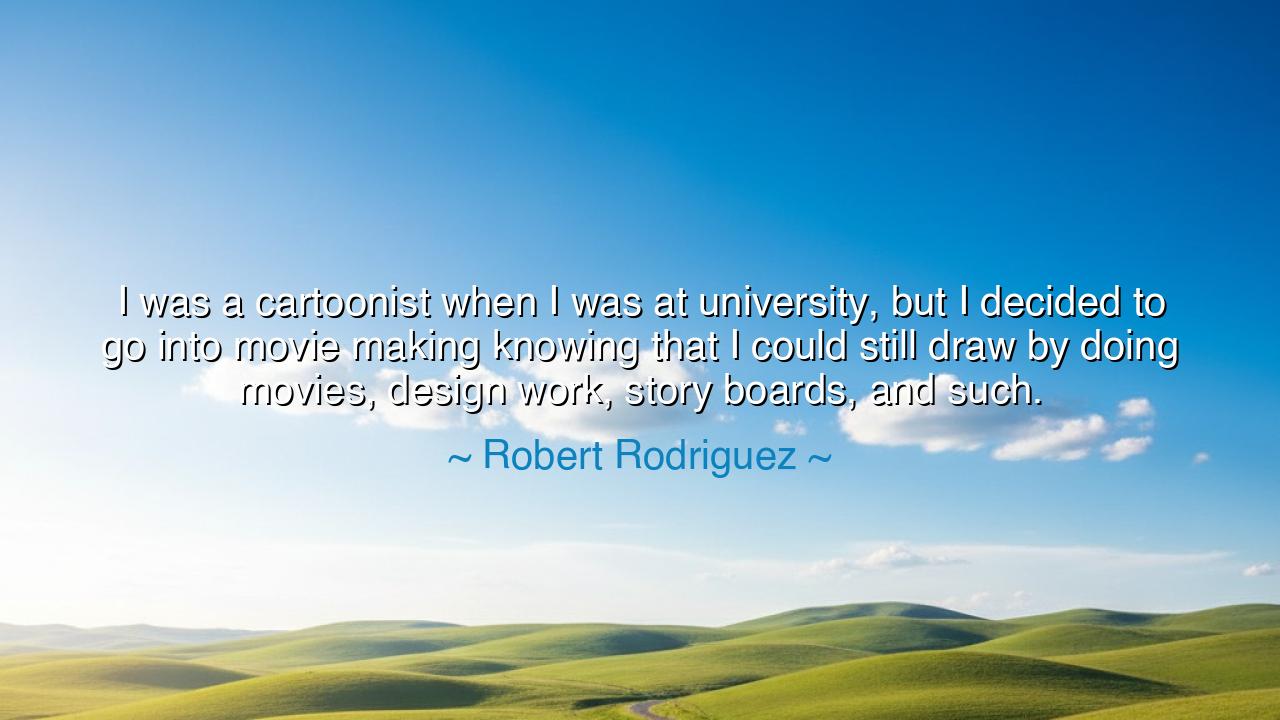
I was a cartoonist when I was at university, but I decided to go
I was a cartoonist when I was at university, but I decided to go into movie making knowing that I could still draw by doing movies, design work, story boards, and such.






The words of Robert Rodriguez—“I was a cartoonist when I was at university, but I decided to go into movie making knowing that I could still draw by doing movies, design work, story boards, and such”—speak to the eternal truth of adaptation, the art of carrying one’s essence into new forms. In these words, Rodriguez reveals a lesson older than any craft: that the creative spirit is not bound to one path, but can flow like a river, finding new courses when the old ones narrow. His journey from drawing to filmmaking is not a departure, but an evolution—a transformation of one gift into another, showing that art, when true, transcends medium.
To draw is to see—to observe the world and shape it through the hands. To film is to do the same, only with light and motion instead of ink and line. Rodriguez understood this kinship between disciplines. In his youth as a cartoonist, he learned the rhythm of storytelling—the composition of emotion through image, the balance of detail and space. When he turned to filmmaking, he carried these lessons with him, for every shot in cinema is a drawing come alive, every storyboard a whisper of the future scene. His words remind us that no act of creation is wasted, and that skills from one art may awaken new life in another.
This understanding has deep roots in the wisdom of the ancients. The great polymaths of history—Leonardo da Vinci, Michelangelo, Aristotle—knew that the boundaries between crafts are illusions. Leonardo, who painted the Mona Lisa, also studied anatomy, built machines, and designed the flow of water, for he saw all creation as one great conversation between imagination and form. So it was with Rodriguez: he refused to imprison his creativity within a single medium. Instead, he treated each art as a new language through which the same soul could speak. This is the secret of all true creators—to see unity where others see division.
To adapt does not mean to abandon one’s roots, but to let them spread wider. Rodriguez did not stop being an artist when he put down his pen; he simply drew upon the world itself. The camera became his brush, the frame his canvas, and motion his line of expression. This spirit of transformation is the essence of survival and growth. The musician who turns to writing, the soldier who becomes a teacher, the dancer who learns to sculpt—all follow this same eternal pattern. The ancients called it metamorphosis, the sacred change through which one form gives birth to another without losing its inner essence.
In Rodriguez’s story, we also find courage—the courage to leave what is known for what might be greater. He could have remained comfortable in the safety of his talent as a cartoonist, but he chose instead the unknown vastness of cinema. This leap of faith is the mark of all who walk the creative path. For to follow one’s art is to walk between certainty and discovery, between control and wonder. The heart that dares this journey must trust that every skill, every experience, will find its place in the tapestry of what comes next.
Consider the tale of Walt Disney, who also began as a cartoonist and animator. From his sketches of a cheerful mouse, he built not just films but worlds—realms of imagination where art became motion and fantasy took physical shape. Like Rodriguez, Disney understood that each discipline is a bridge, not a boundary. What begins as a drawing may one day become a kingdom. His story, too, teaches that to evolve is not to betray one’s beginnings, but to fulfill them. The seed must change form to bear fruit, yet its essence remains.
Rodriguez’s words therefore hold a timeless lesson: do not cling to form—cling to purpose. If you are an artist, do not fear to change the canvas; if you are a thinker, do not fear to change the tools of your thought. What matters is not the instrument, but the vision that guides it. The one who truly knows their craft can carry it anywhere, translating it into new expressions without losing its spirit. As Rodriguez shows, the artist’s task is not to repeat, but to reinvent—to find new ways to tell the same story of the human soul.
Let this then be the wisdom for all who create, or seek to create: trust your evolution. When life calls you to a new path, answer it with curiosity, not fear. Know that every skill you have honed, every passion you have nurtured, will serve you again in ways you cannot yet imagine. As Rodriguez discovered, to change one’s art is not to lose it—it is to let it live. So whether you draw with ink, light, word, or sound, remember: the true artist never stops drawing—they simply find new worlds to draw upon.






AAdministratorAdministrator
Welcome, honored guests. Please leave a comment, we will respond soon